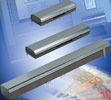Highly accurate pattern recognition sensors
23 January 2008
Opto-Electronics

Murata has released four new products in its BS05 series of magnetic pattern recognition sensors. The BS05M1HFAL, BS05M1KFCA, BS05M1KFFA and BS05M1KFBB magneto-resistive sensors are designed for ATMs, banknote counters, detectors and other validation applications.
The devices are suitable for detection of magnetic thread or magnetic ink, and enable simple and quick mounting. They retain around 70% of their output voltage at a 0,1 mm gap between sensor and substrate, compared to just 4% for typical coil head sensors. Along with their stable frequency characteristic, which is independent of the scanning speed, this makes them suitable for high-speed processing devices that demand high accuracy.
Magneto-resistive sensors consist of a permanent magnet and two sensing elements to ensure compensation for changes in temperature. When a magnetic material is passed over the sensor, the elements detect a change in the magnetic flux density, which is converted into an electrical signal. In banknote validation applications, the sensor is typically mounted beneath a pressure roller which helps keep the banknote in contact with the sensor's surface. In Murata's multichannel devices, multiple sensors are mounted next to each other, to allow magnetic pattern recognition over the whole width of a banknote.
The BS05M1HFAL is an 8-channel sensor with channel width of 3 mm, while the BS05M1KFFA has 13 channels, each 10 mm wide. Both have all their channels mounted in a straight line. This layout is especially useful in banknote validators that use a pressure roller, as the centre of the roller can be directly above the line of sensing elements, leading to lower signal loss and eliminating time differences between signals. The in-line layout also eases handling and PCB assembly and reduces the size of the pressure roller and sensing assembly.
The BS05M1KFCA six-channel and BS05M1KFBB 13-channel sensors have 10 mm channel widths with channels offset in alternate directions to make a zigzag style configuration. This ensures there is no physical gap between each channel, leading to very reliable detection of banknotes. These sensors are therefore targeted at high end machines that have high scanning speed and require high detection reliability.
Further reading:
Easy Nixie tube display
Dizzy Enterprises
Opto-Electronics
MIKROE has launched Nixie Power Click, a booster Click board designed to provide high voltage for powering Nixie Tube (cold cathode display) shields.
Read more...
Advanced HMI delivers enhanced durability
Fox Controls Rand
Opto-Electronics
This compact touchscreen HMI from IDEC provides essential visualisation and high-performance multitouch control, even in the most space-limited applications.
Read more...
Powerful UVC disinfection
Opto-Electronics
The S3535-H emitter generates an output power of more than 150 mW per chip at 265 nm, providing the strongest germicidal effect currently available on the market.
Read more...
Front panels for electronics
Seven Labs Technology
Opto-Electronics
In the world of electronics, the significance of a well-designed front panel cannot be overstated as it serves not only as the first point of interaction between users and devices, but also plays a crucial role in the functionality and aesthetics of electronic products.
Read more...
Cree: Illuminating the future of LED technology
Altron Arrow
Editor's Choice Opto-Electronics
As a pioneer in this field, Cree LED has been instrumental in shaping the LED landscape, driving innovation and performance in this sector.
Read more...
New optical sensors for object detection
Opto-Electronics
A special feature of the Würth Elektronik sensors is that they filter out visible light up to 800 nm, rather than just up to 700 nm, like many other sensors of this type.
Read more...
HTML5 WebPanel with Linux, Android, or AutomationBrowser
Vepac Electronics
Opto-Electronics
Having a front protection rating of IP65, and additional features such as Wi-Fi, Bluetooth, USB, RS232 integrated, these panels are an excellent solution for most industrial applications.
Read more...
Laser control for smart glasses
Opto-Electronics
TDK has developed the world’s first full-colour laser control device for 4K smart glasses using lithium niobate thin film.
Read more...
PVision introduces interactive PoS to South Africa
Opto-Electronics
Recently, PVision partnered with Nexmosphere, a company that transforms any digital display into an engaging experience using sensors and controls, to bring the next level of point-of-sale digital displays to consumers.
Read more...
InGaAs and SWIR surveillance
Opto-Electronics
Sensing in the SWIR range (wavelengths from 0,9 to 1,7 microns) has only recently been made practical by the development of Indium Gallium Arsenide (InGaAs) sensors.
Read more...

